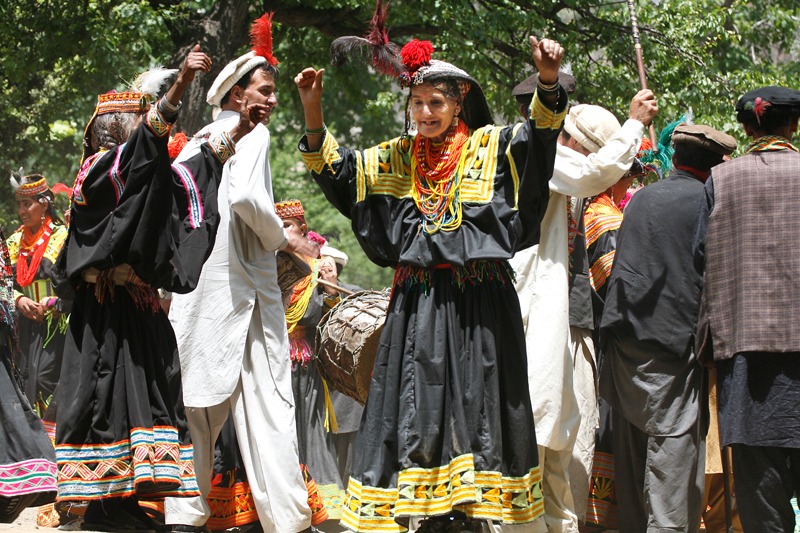About us
Visit Chitral Valley is a destination brand developed by STFP which is dedicated to promote Responsible Tourism in the Valley of Chitral. We offer not just information about the tourist places of Chitral Valley but we also offer holidays experiences that would stay with our customers forever. We understand all the needs of our clients and develop travel plans as per their particular interest if it is in history, culture, adventure or in the rich ecology of this beautiful region of Pakistan.
Through our close working relationship with the local communities, hotels, tour guides and transport service providers, we create a wide range of packages and customized tours as per the needs and requirements of our customers. Providing best quality services in affordable rates is our top most priority.
As a member of Sustainable Tourism Foundation Pakistan (STFP) we are committed to sustainable tourism and the protection and preservation of mountain habitat and local communities.
Chitral Valley
Surrounded by some of the tallest mountains in the world, Chitral is Pakistan’s northern most districts and perhaps one of the best destinations for adventure, culture and ecotourism in the country. Area wise it is the largest district of Khyber Pakhtunkhwa Province. The valley is bounded on the north-west by the mountains of Hindukush and share border with Afghanistan. On the north-east by the mountains of Karakoram and on the south by the Hindu Raj range. There are more than 40 peaks over 6,100m packed in the area of 14,850 square kilometres, altitudes in this rugged terrain range from 1,094m at Arandu to 7,726m at Tirichmir. The Chitral valley and its subsidiary valleys are drained by the Chitral River, which is known by different names along various stretches, and its tributaries. Originating in the Chiantar glacier, the river enters Afghanistan at Arandu.
History of Chitral
Situated on the main crossroad to Central Asia, Chitral has a long and fascinating history. In fact, it is this strategic location that compelled invaders to capture it before any other area in the region. The recorded history of Chitral begins with the Tibetans invading Yasin Valley in the 8th Century AD, followed by the Chines in 750 AD and the Buddhists in 900 AD. Later, the Kalash also ruled Chitral for decades.
In the 14th Century, Chitral became a unified independent kingdom under the rule of Shah Nasir. In 1570, the Raise Dynasty was replaced by the Katoor Dynasty. The famous Mehtar of Chitral Aman-ul-Muluk ruled from 1857 to 1892. In 1895, the siege of Chitral Fort took place and lasted a month, after which Chitral remained an independent state under British rule.
When Pakistan came into being, the state of Chitral was the first to declare accession to the new country. In the year 1969, Chitral was merged into the Malakand division of then NWFP as a settled district of Pakistan.
Chitral is connected to the rest of Pakistan by two land routes, via Lowari Pass/tunnel from Dir and via Shandur Pass from Gilgit-Baltistan. Both the passes are closed in winter due to snowfall. The Lowari Tunnel opened last year now provides a year around access to the areas beyond Lowari Pass. There are number of other high passes which provide access on foot to Chitral from the areas of Upper Swat, Upper Dir and Gilgit-Baltistan.
People of Chitral
The area that is now Chitral has been inhabited for at least 4000 years. Its people belong to over a dozen different cultures and speak more than 14 languages. As a result of its unique location and historical links with Central Asia and Europe, the material and non-material culture of Chitral bears traces of Greek, Iranian, Mongolian, Tatar and Turk influences.
The people of Chitral have a great ethnic diversity. Some tribes existing in the area include Katoray, Mehtar, Quraysh, Khow etc. The biggest tribe in the district is Khow, their origins are from Aryan ancestry and some believe that they come from central Asia, Afghanistan and Kashmir. Chitral is also home to the famous aboriginal tribe of the Kalash who are now confined to the three valleys of Bamburiat, Rambur and Barir. The total population of Kalasha people is roughly around 4,000 individuals and they are considered one of the most endangered indigenous people in the world.
According to the 2017 census, population of Chitral district stands at 447,362 (225,846 males and 221,515 females). These statistics show that the population has increased at an average rate of 1.8% annually since the census of 1998. Close to 90% of the population reside in rural settlements. Chitral town is the only urban settlement in the district.

Weather of Chitral
The weather of Chitral is extremely harsh and cold in the winter and pleasant in the summer. Mostly tourist visit Chitral during summer months from May to August. Average temperatures in summer range from 25 to 40 degrees Celsius, while in winter it plunge below minus. Since Chitral is surrounded by high mountains, it does not receive the monsoon rains. Mean rainfall in Drosh and Chitral towns (Lower Chitral) is approximately 850mm and 500mm, respectively, occurring mainly in the spring and winter. Summer and autumn are dry, with the area receiving barely 10-15 mm of rain per month. In Upper Chitral, annual precipitation is as low as 200mm, received mostly as snow in the higher elevations. In winter the night temperature occasionally drops to -10 degrees Celsius. Winter snowfall in the town can be quite heavy with an accumulation of up to two feet being quite common.
Flora and Fauna of Chitral
Nestled between the Hindukush and Hindu Raj mountains, the Chitral valley provides ideal growing conditions for at least 64 endemic plant species. Chitral’s flora is similar to the Central Asia, and comprises moist alpine pastures, subalpine birch, moist deciduous alpine scrub, dry temperate coniferous scrub and dry oak scrub forest types. The fauna, meanwhile, resembles that of the Western Palaearctic Faunal Region, with a slight oriental mix from the south. Wide variations in altitude, from 1,094m at Arandu in the south to 7,726m at Tirichmir in the north, compensates for the arid climate, making the area an ideal habitat for variety of plants and animals. Chitral also serves as a corridor for the seasonal migration of birds. Approximately 1 million migratory birds pass through this area each year, of which several are globally important species.
The number of mammal species recorded in Chitral to date is 45, which accounts for about half of the all the mammals recorded in the Khyber Pakhtunkhwa as a whole. Wild animals typically found in the region include the Markhor, Ibex, Snow Leopard, Himalayan Lynx, Grey Wolf, Stoat, as well as two species of bat.
So far, 195 species of resident and migratory birds have been recorded in Chitral, several of them are endangered. Chukar, Ram Chukar, Monal pheasants are among some of the globally significant bird species found in this region. Bird of prey, particularly the Peregrine Falcon and Saker Falcon, inhabit the northern reaches of the valley. Several species of waterfowl, some of which are endangered, migrate along Chitral River in the autumn and spring, providing hunting opportunities to local residents.
Cultural Heritage of Chitral
Chitral’s unique culture has developed over many millennia, with more than a dozen ethnic groups speaking as many languages scattered across isolated mountain valleys. Many of the ancestors of Chitral’s present day inhabitants fled to these valleys to escape the turmoil of surrounding countries. As a result, the culture of the people of Chitral is more closely linked to the culture of Central Asia and China, rather than the rest of South Asia.
Architecture and Historic Sites
Chitral district has also number of sites which are of archaeological and historical interest. The royal forts at Chitral town, Birmogalasht, Mastuj, Drosh, Nagar, Shoghore are now privately owned and in varying stages of decay. In addition to these forts, Chitral is home to several single and double storied old houses build in typical Khow and Kalash style. The traditional Khow house, or Baipash, provides several facilities under one roof (bedroom, drawing room and kitchen). These traditional Chitrali buildings are embellished with exquisite wood carvings.
Chitral is also home to a number of heritage sites where important battles were fought in the past. Chokul What, Darband, Gasht, Jutilasht, Khandan, Khorkashandeh, Nisur Gol, and Rabat are among the dozens of such areas of historical interest.
Arts and Crafts
Chitral’s artisans manufacture a wide range of elegant and delicately crafted products, including pottery, weaponry and jewellery; woodwork; and embroidered, woven and knitted textiles. Clay, wood, stone, bone, animal skin and copper are the materials most commonly used. Chitral’s woollen fabric, Shu or Patti, embroidered cloth and walnut-wood furniture are popular in handicraft markets throughout the country.
Traditional Khow and Kalash clothing is made from wool and silk, decorated with beads and shells. The traditional cap (Pakol) and Chitrali gown (chugha) are popular items among tourists.
Music, Dance and Folklore
Music and dance are at the heart of Chitrali culture. The performance of music is not considered to be profession confined to a few families, as it is the case in the rest of the sub-continent. Rather, Chitral’s rich and varied musical tradition is part of the fabric of everyday life. Every occasion calls for a different rhythm, while certain beats are served for particular individuals. The Chitrali sitar is famous throughout the world and traditional dances, such as the dani and souz, are part of folk heritage of Central Asia.
Folk songs serve as repository of regional history. The folk poets of Chitral sing war songs as well as love ballads, Epics are popular among the Kalash, while Khowar poets prefer romantic verse. Elements of nature and the environment are also depicted in these songs.

Local Games and Sports
Polo and falconry are the most popular recreational pursuits in Chitral. Local people hunt for sport as well as to supplement their diet. Polo is the most popular sport in Chitral and an annual polo festival takes place between Gilgit and Chitral at the highest polo ground in the world, at the Shandur Pass in upper Chitral.
